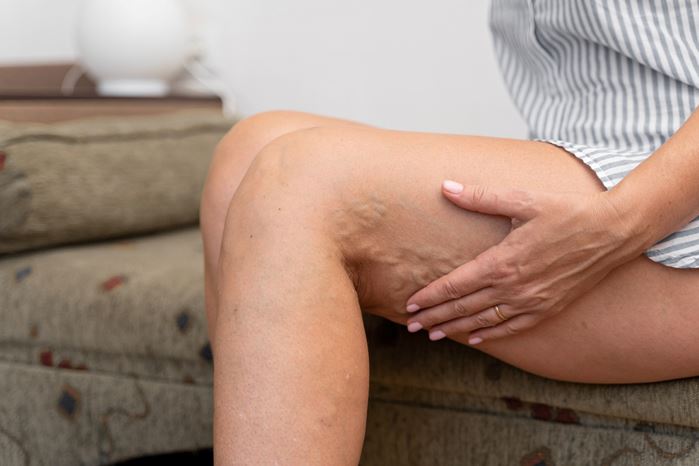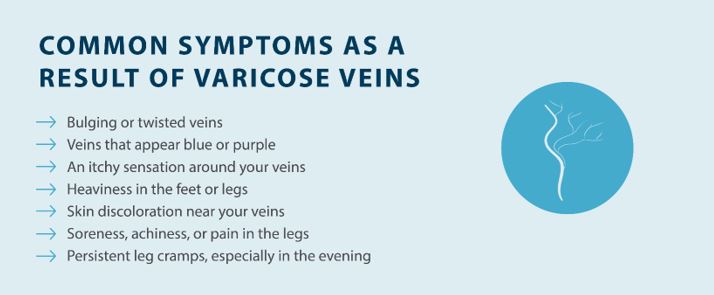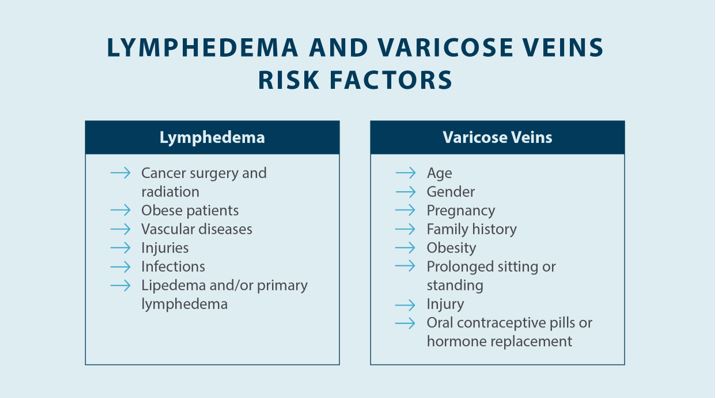Lymphedema and Weight Loss
Living with lymphedema while trying to manage your weight can feel overwhelming, but understanding the connection between lymphedema and weight loss can help you develop effective strategies for both conditions.
Read More

In many cases, lymphedema and chronic or worsening varicose veins present with similar symptoms. This may lead you to wonder whether lymphedema and varicose veins are connected. While lymphedema and varicose veins are two separate conditions, the symptoms of the two can overlap, and both conditions are related to the movement of fluid in the body.
In this article, we take a closer look at the link between varicose veins and lymphedema while touching on the symptoms and risk factors for each condition. Read on to learn more about varicose veins and lymphedema, or use the links below to skip to a specific question to learn more.
What Is Lymphedema?
What Are Varicose Veins?
How Are Varicose Veins and Lymphedema Connected?
Who Is at Risk for Lymphedema?
Who Is at Risk for Varicose Veins?
How Do You Treat Lymphedema?
How Do You Treat Varicose Veins?
Can Varicose Vein Treatment Cause Lymphedema?
Wrapping Up: Varicose Veins and Lymphedema
Lymphedema is a medical condition that’s characterized by a buildup of lymph fluid, which can lead to swelling and pain in the affected body parts. Lymphedema stems from a disruption to the body’s lymphatic system, which regulates the movement of lymph fluid as it passes through lymph vessels and nodes. Damaged lymph vessels nodes can be a primary contributor to lymphedema, as damage to either can prevent the flow of fluid, leading to swelling and other symptoms.
It is also important to note that lymphedema comes in several forms. Primary lymphedema is a relatively rare genetic condition that is characterized by an underdeveloped or malformed lymphatic system. Secondary lymphedema, on the other hand, is much more common and can be caused by any direct trauma to the lymphatic system, including cancer treatment such as chemotherapy, surgery or radiation, acute injuries, obesity, or vascular disease.
It’s important to familiarize yourself with the symptoms of lymphedema so that you can identify the condition sooner rather than later. While lymphedema commonly manifests in the arms or legs, it can also impact your neck, chest, abdomen, and genitals. Some of the common lymphedema symptoms to watch out for include:
Varicose veins refer to enlarged and twisted blood vessels. Since these blood vessels are located just beneath the skin’s surface, varicose veins are often very visible and will appear as purple or blue bulges. In most cases, varicose veins develop in one’s legs, ankles, or feet, yet they can form in other parts of the body as well.1

Varicose veins are caused by the valves in blood veins becoming weak. Normally, these valves keep blood moving up the limb back toward the heart. However, when the valves are weak, either due to a genetic component or injury, this can cause blood to flow backward in the veins. The backflow will cause the veins to engorge with blood, resulting in the vein becoming enlarged and twisted. otherwise referred to as a varicose vein.
In general, varicose veins are not a cause for concern but rather a cosmetic issue. However, varicose veins can cause aching pain, itching, and discomfort. In some cases, varicose veins can eventually lead to more serious health problems, such as ulcers or blood clots.
Varicose veins can often be visually identified on one’s body. While varicose veins are not typically a serious health condition, it is important to recognize the symptoms so that you can monitor the condition and take action if your varicose veins begin to impact your quality of life or develop into a more serious issue. With that being said, some of the main symptoms of varicose veins include:2

While varicose veins and lymphedema are separate medical conditions, there are several ways in which they are similar. One of the main similarities these two conditions share is the fact that they both affect the circulation of fluid in the body. Varicose veins are the result of a problem with the circulation of blood in the body, while lymphedema indicates a problem with the body’s lymphatic system, which is responsible for circulating lymph fluid.
Additionally, varicose veins and lymphedema often present similar symptoms. For instance, both chronic or worsening varicose veins and lymphedema can cause heaviness in the limbs, pain and swelling, and skin discoloration. In certain cases, treatment methods for both of these conditions can also be similar. Your doctor may outfit you with compression wraps or sleeves to discourage swelling and promote fluid circulation within the body.
Lymphedema is more common than many realize. Thus, it’s important to familiarize yourself with lymphedema risk factors so that you can identify this condition early on to take action. So, who is at risk for lymphedema? Common causes of lymphedema include:

While varicose veins are often treated as a cosmetic issue, they do have the potential to cause blood clots and create or exacerbate other health conditions, such as lymphedema. This is why it is important to understand the common risk factors and causes of varicose veins. Some of the potential causes of varicose veins can include:2
Unfortunately, there is no cure for lymphedema. However, there are several treatment options available that can help mitigate lymphedema symptoms, enabling you to manage the condition and maintain your quality of life. Below are a few of the available treatment options for those suffering from lymphedema:
As with any medical condition, prevention can help you slow down the progression of symptoms associated with lymphedema. While you may not be able to stop the onset of lymphedema altogether, you can minimize the progression of symptoms by taking preventative steps. If you are concerned about lymphedema, some of the preventative measures you can take include:
As with lymphedema, there are several treatment options available for varicose veins. Most varicose vein treatments are minimally invasive and aim to close off problematic veins while promoting blood flow across healthy veins. With that being said, treatment options for varicose veins include:3
Certain surgical procedures, such as vein stripping, can potentially lead to lymphedema in some patients. This is because lymphedema can be caused by physical injuries and scar tissue that results from surgery. Infections that occur because of surgery can also potentially lead to lymphedema.
However, other treatment methods for varicose veins are less likely to lead to lymphedema. For example, some research suggests that non-invasive procedures such as laser treatment and sclerotherapy can minimize the risk of lymphatic complications occurring as a result of treatment.4
Varicose veins and lymphedema are similar in that both conditions impact the circulation of fluids in the body and, in some cases, they present similar symptoms. Symptoms such as a heaviness of the limbs, pain, swelling, and skin discoloration can be caused by both of these conditions, yet varicose veins are accompanied by external signs that make it easier to distinguish between the two.
If you have been diagnosed with lymphedema or believe you are at risk of developing it, it is important that you take steps to reduce symptoms and manage your condition. Undergoing complete decongestive therapy, wearing compression garments, or even learning how to do a lymphatic massage can all help prevent and treat lymphedema.
In addition to the methods mentioned above, you might also consider trying out the Flexitouch Plus system or Nimbl System from Tactile Medical to treat and manage lymphedema symptoms. This system allows those dealing with lymphedema to target problem areas and obtain convenient at-home treatment. Reach out to our team today to learn more about how our research-backed products can help you find relief from lymphedema.
1. Johns Hopkins Medicine. Varicose Veins. https://www.hopkinsmedicine.org/health/conditions-and-diseases/varicose-veins
2. National Heart, Lung, and Blood Institute. Varicose Veins. https://www.nhlbi.nih.gov/health/varicose-veins
3. Brigham and Women’s Hospital. Venous and Lymphatic Disorders. https://www.brighamandwomens.org/heart-and-vascular-center/diseases-and-conditions/venous-and-lymphatic-disorders
4. Vignes S. Treatment of varicose veins and limb lymphedema. J Mal Vasc. 2014 Feb;39(1):57-61. 2013 Dec 6. https://pubmed.ncbi.nlm.nih.gov/24315933/
Living with lymphedema while trying to manage your weight can feel overwhelming, but understanding the connection between lymphedema and weight loss can help you develop effective strategies for both conditions.
Read More
Stage three lymphedema is the most advanced stage of this chronic condition. In this stage, the affected body part might display one or more symptoms, such as significant swelling, alterations in the skin, or recurring episodes of infection. While this stage can be challenging to manage, understanding your condition and...
Read More
When the lymphatic system becomes compromised, fluid buildup can lead to stage 1 lymphedema, a condition marked by mild but noticeable swelling in affected areas. This initial stage is a crucial window for intervention, as proper treatment can prevent progression to more severe stages. Knowing the signs, causes, and treatment...
Read More
Living with stage 2 lymphedema brings unique challenges, but understanding your condition is the first step toward effectively managing it. While this stage marks a point where the condition becomes irreversible, there are many ways to maintain your quality of life and prevent symptoms from progressing. Keep reading to explore...
Read More
Call us at 1.800.575.1900